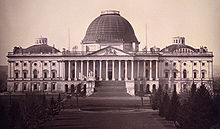Thirty-fourth United States Congress
| 34th United States Congress | |
|---|---|
|
33rd ←
→ 35th
|
|

United States Capitol (1846)
|
|
| March 4, 1855 – March 4, 1857 | |
| Senate President | Vacant |
| Senate Pres. pro tem |
Jesse D. Bright (D) Charles E. Stuart (D) James M. Mason (D) |
| House Speaker | Nathaniel P. Banks (KN) |
| Members | 62 Senators 234 Representatives 7 Non-voting members |
| Senate Majority | Democratic |
| House Majority | Opposition coalition |
| Sessions | |
|
1st: December 3, 1855 – August 18, 1856 2nd: August 21, 1856 – August 30, 1856 3rd: December 1, 1856 – March 4, 1857 |
|
The Thirty-fourth United States Congress was a meeting of the legislative branch of the United States federal government, consisting of the United States Senate and the United States House of Representatives. It met in Washington, D.C. from March 4, 1855 to March 4, 1857, during the last two years of Franklin Pierce's presidency. The apportionment of seats in the House of Representatives was based on the Seventh Census of the United States in 1850. The Whig Party, one of the two major parties of the era, had largely collapsed, although many former Whigs ran as Republicans or as members of the "Opposition Party." The Senate had a Democratic majority, and the House was controlled by a coalition of Representatives led by Nathaniel P. Banks, a member of the American Party.
The count below identifies party affiliations at the beginning of this Congress. Changes resulting from subsequent replacements are shown below in the "Changes in membership" section.
During the elections for this Congress, opponents to the Democrats used the Whig party label inconsistently and not at all in some states. Hence in this Congress, and in accordance with the practice of the Senate and House, representatives not associated with the Democratic Party or the American Party are labeled as "Opposition." This is the first example in U.S. history of a form of coalition government in either house of Congress.
...
Wikipedia
